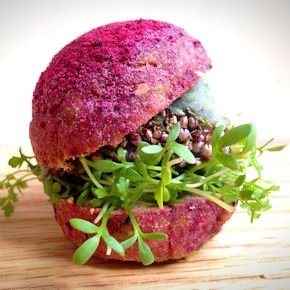In a raw food diet, bread recipes all have in common the lack of leavening and baking. The soft texture is therefore obtained thanks to the use of mucilaginous seeds such as flax, psyllium or chia, adding courgettes, squash or the pulp of a young coconut. Other useful ingredients, though non essential to make the dough soft, are Chondrus crispus (an Irish seaweed) and Eucheuma (a Japanese seaweed), which are prepared by washing them repeatedly, soaking them into water for 5-12 hours and then blending them with water until a gel is obtained, which can then be kept in the fridge for 10 days.
This bread does not contain cereals, yeast, oily seeds and it is gluten free. Its main component is the whole almond flour obtained by processing the milk, so it is very low in fat and has a very high percentage of fibre. The texture is compact and damp, very similar to that of German breads made with whole rye seeds, but has a more delicate flavour. One could also add spices, fresh or dry aromatic herbs, or oily seeds, according to taste.
Raw bread

Raw roll with seasoned fermentino and watercress
INGREDIENTS
60 g whole almond flour
100 g peeled and diced courgette (or squash)
40 g psyllium fibre
27 g flax (or chia) seed flour
8 ml (1 and 1/2 teaspoon) lemon juice
1 e ½ medjoul dates cut into pieces
3 g (½ teaspoon) salt
1 chopped garlic clove
90 ml water
To colour the rolls:
1 tablespoon powdered red onion
1 tablespoon powdered beetroot
1 tablespoon powdered carrot
1 tablespoon powdered pumpkin
1 tablespoon powdered leek
1 tablespoon powdered red cabbage
METHOD
Preliminary preparation of the whole almond flour:
First of all, you need to obtain the almond milk by processing 250 g of non peeled almonds, previously soaked and rinsed with 1.25 l water, then filtered with a gauze, paying attention to squeeze it properly. Let the pup dry for 8 hours at 42°C, then blend it until you obtain a flour (over 60 g), which can be kept for months in a hermetical container.
Preparing the dough:
Process the courgette with the dates, water, salt and garlic. In a large bowl, mix all the dry ingredients. Add the cream and knead with your hands until you obtain a texture that can be moulded. If necessary, add a little water. Form a long loaf or 6 small rolls.
To complete the rolls, brush their surface with some water and sprinkle the coloured flours on top. Dry them at 55°C for 30 minutes and then at 42°C for 9 hours.
The loaf, instead, needs to be dried for 1 hour at 55°C, and then for 14-19 at 42°C. During the higher temperature drying, a crust will form outside while the inner part will never go over 42°C.
After this time has passed, the loaf can be cut into 1 cm thick slices and left to dry fro another hour or you can eat it straight away.
It can be kept in a hermetical container in the fridge for four days.